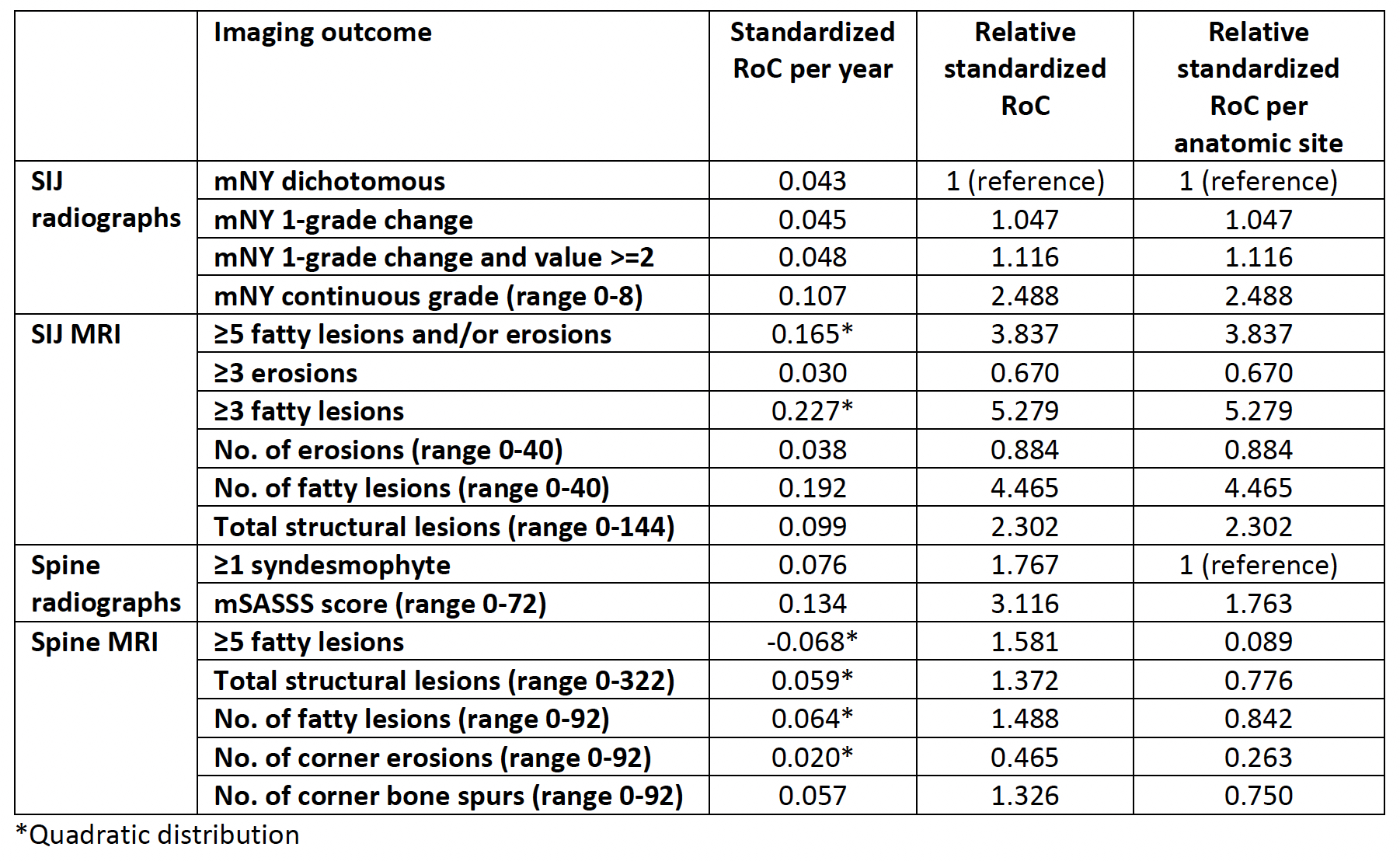Session Information
Session Type: Poster Session C
Session Time: 9:00AM-11:00AM
Background/Purpose: The change over time of the structural damage of axial spondyloarthritis (axSpA) is important to consider since it may reflect the severity of the disease. In axSpA this structural damage can be evaluated either at the sacroiliac joints (SIJ) or spine level, and also either on conventional radiographs or Magnetic Resonance Imaging (MRI). The objective of this study was to evaluate the sensitivity to change of different structural imaging outcomes over 10 years of follow-up in patients with early axSpA.
Methods: Patients from the DESIR inception cohort (≤3 years of symptoms) axSpA (according to the treating rheumatologist) from the DESIR cohort were included. Radiographs and MRI of the SIJ and spine were obtained at baseline, 1, 2, 5 and 10 years. Images were scored in four separate reading waves by 3 trained central readers (wave 1 only 2 readers with one adjudicator) unaware of chronology. The yearly rate of change (RoC) of each outcome was analyzed using generalized estimation equations (GEEs) including all patients with ≥1 score from ≥1 reader from ≥1 wave and using time (years) as explanatory variable and adjusting for reader and wave. All outcomes (Table) were standardized (difference between the individual’s value and the population mean divided by the population SD). In addition, the relative standardized RoC (i.e., the standardized yearly RoC of an outcome divided by the corresponding rate of a reference imaging outcome) was calculated, with a value >1 reflecting larger sensitivity, and < 1 lower sensitivity compared to the reference. Finally, the relative standardized ROC per anatomic site was calculated.
Results: A total of 704 patients (46% males and mean age 33.7 years) were included. Among all locations and modalities, the change in ≥3 fatty lesions was the outcome with the highest sensitivity to change (standardized RoC 0.227 per year). The two most sensitive to change outcomes in SIJ (both MRI and radiographs) were ≥3 fatty lesions, with a standardized RoC per year of 5.279, which is 5.3 times higher than the RoC of the definitive damage on pelvic radiographs according to the modified New York criteria (mNY) criteria (reference), followed by the absolute number of fatty lesions also 4.5 times more sensitive than the reference. Similarly, the most sensitive to change lesion in the spine (both MRI and radiographs) was the mSASSS score, which was 1.8 times more sensitive than the reference, i.e. ≥1 syndesmophyte.
Conclusion: MRI structural outcomes in the SIJ, in particular fatty lesions, are more sensitive to change than radiographic outcomes. On the other hand, mSASSS remains the most sensitive method, even if compared to MRI of the spine.
To cite this abstract in AMA style:
López Medina C, Molto A, Sepriano A, Ramiro S, Dougados M. Sensitivity to Change of Structural Outcomes in Early Axial Spondyloarthritis After 10 Years of Follow Up. Data from DESIR Cohort [abstract]. Arthritis Rheumatol. 2023; 75 (suppl 9). https://acrabstracts.org/abstract/sensitivity-to-change-of-structural-outcomes-in-early-axial-spondyloarthritis-after-10-years-of-follow-up-data-from-desir-cohort/. Accessed .« Back to ACR Convergence 2023
ACR Meeting Abstracts - https://acrabstracts.org/abstract/sensitivity-to-change-of-structural-outcomes-in-early-axial-spondyloarthritis-after-10-years-of-follow-up-data-from-desir-cohort/

